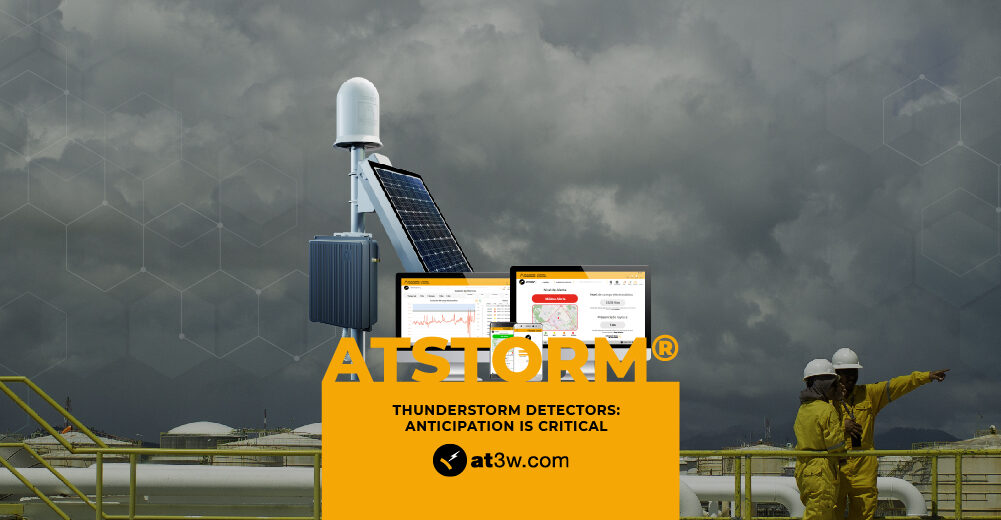The local detection of electrical storms is key in preventing occupational hazards. By adopting temporary measures before the lightning strike alert, accidents, damage to infrastructure and property, and even environmental disasters can be avoided. However, it is necessary to have sufficient anticipation time, especially in cases where the implementation time of preventive measures is high. Reliable electrical storm detectors target decision-making, allowing the correct management of preventive actions.
Every year there are more than 24,000 deaths and 240,000 injuries worldwide from lightning strikes. We should be able to prevent all these deaths, injuries and property damage, but we are still far from achieving this goal. However, these deaths and injuries due to lightning have been continuously reduced over the last century, thanks mainly to lightning prevention and protection measures, whether permanent such as lightning rods and surge protectors, or temporary through preventive actions. Temporary measures are adopted in light of the lightning strike risk alert and are deactivated when the danger has passed, such as evacuating personnel, stopping or postponing dangerous activities, etc.
In general, the decision to implement these preventive measures is based on subjective criteria such as the distance at which lightning strikes or the shades of gray from the clouds. This unnecessarily exposes personnel to risky situations or causes significant financial losses. Given the risk of lightning, premature shutdowns of activity entail economic losses while, if the shutdown is carried out too late, human lives may be at risk. In the same way, returning to normal activity too soon exposes staff again, and excessive downtime carries financial costs.
Fortunately, there are security tools that, complying with the international standard IEC 62793: 2020 “Lightning protection – Storm warning system2“, facilitate decision-making through objective information that allows the correct management of preventive measures. For this reason, a reliable detector of electrical storms is necessary, which warns of the formation or approach of storms to the work area, to adopt the appropriate temporary3 measures.
The key to avoiding accidents and financial damage due to electrical storms is to properly manage preventive measures. The information provided by a reliable thunderstorm detector makes it possible to objectify decisions
Next, we will expose the types of storm detectors that exist relating them to the anticipation time they provide. The IEC 62793: 2020 standard establishes various situations as dangerous, for example, concentrations of people in open areas either for work or leisure reasons, wind farms, solar parks, supply lines, infrastructures such as ports and airports, basic services health and telecommunications, civil protection of the environment, etc. In this article we will focus on some of the sectors that require a longer start-up time for preventive measures, such as wind power, mining and concentrations of people in open spaces.
Electromagnetic field based storm detectors vs electrostatic field based detectors
Current thunderstorm detectors can be classified into two categories: electromagnetic field-based detectors, which measure the electromagnetic radiation produced by lightning, and those based on the measurement of the electrostatic field. The lead time offered by the two types of thunderstorm detectors is different, which has consequences when taking preventive measures.
Sensors based on electromagnetic field require an initial discharge to be able to warn of the approaching thunderstorm. Due to this limitation, electromagnetic field detectors are not useful when the storm is forming directly on the target or is approaching without discharging any lightning. In fact, according to a 2005 study, 54% of the lightning strike victims did not receive notice of the threat because there was no lightning strike prior to the impact (within a 20-kilometer radius) or previous strikes They happened in a short space of time that left no margin to seek a suitable refuge. Also the National Oceanic and Atmospheric Administration (NOAA) of the United States indicates that the majority of accidents by lightning strike occur at the beginning or end of electrical storms. Another limitation of electromagnetic field detectors arises here, as they determine the absence of risk simply by using a countdown from the last detected discharge. If a predetermined time is reached (generally 30 minutes, but in the wind sector it can be 1-2 hours), the electromagnetic field-based detector will issue an absence of risk warning. However, a shock may occur right after, or the downtime may have been too long.
Not all thunderstorm detectors provide sufficient advance notice to take preventive action.
In addition, electrical storm detectors based on electromagnetic field base their alarm of risk on the distance of the previous discharge. That is, they assume that the greater proximity of the discharges implies that the storm is approaching the area to be protected, when it is not necessarily so. For that reason, when subsequent storm discharges move away from the target there are unnecessary stops and evacuations that could have been avoided along with their associated costs.
Currently, the only systems that detect all phases of the storm defined by the IEC 62793: 2020 standard are electrostatic field-based sensors. These detectors measure the atmospheric electrostatic field from which the real probability of lightning discharge can be known. Electrostatic field measurement is the only direct and unequivocal indicator of the risk of lightning strike before it occurs.
Knowing precisely and reliably the formation and approach of electrical storms allows the deployment of temporary prevention actions that can avoid or at least minimize damage. Thus, decision-making does not depend on subjective criteria such as the distance or the gray tones of the clouds, but the objective measurement of the electrostatic field allows stopping the activity for only the necessary time, avoiding unnecessary stops and evacuations produced, sometimes , by electromagnetic detectors.
The most complete electrical storm detector on the market, the result of more than 15 years of accumulated experience, is the local ATSTORM® alert system. Remotely controlled by the expert staff of Aplicaciones Tecnológicas S.A, it allows objectifying decision-making in the face of the risk of lightning strikes. Its alarms are based exclusively on electrostatic field measurement, which is the only solid preventive protection, as it monitors the gradual formation of electrical storms, from their initial phase until good weather.
ATSTORM® measures the variation of the electric field of storms that form in the area and of active storms that approach within a radius of 20 kilometers. In addition, when storms form on the target to be protected or approach without discharging any lightning, detectors based on electromagnetic emissions from lightning do not provide any anticipation time, while ATSTORM® technology provides the necessary margin to take the precautionary measures.
ATSTORM®, a local storm detection system, provides accurate and reliable information on storms in the area well in advance for preventive purposes.
The ATSTORM® storm detector also incorporates an electromagnetic field-based sensor that monitors the approach of active electrical storms up to a radius of 40 kilometers. This sensor allows the monitoring area to be extended, as well as to define a pre-alert state in the face of active electrical storms that approach the target to be protected
Anticipation is critical
Although the anticipation time for the risk of lightning strike is an important factor for any industry, there are certain sectors where this issue is especially critical because they require more time to implement preventive measures. In situations in which there are no suitable shelters for lightning protection in the vicinity, such as golf courses and other outdoor activities, beaches, natural parks, wind farms, etc., it is necessary to enough time for the evacuation of the people who are in the place. In other cases, this anticipation time is necessary to stop potentially dangerous activities such as airports, seaports, mining and petrochemicals, among other sectors.
Any stop or evacuation entails economic costs, so it is not advisable to stop prematurely (if there is no risk) or to return to normality too late (when the storm has already dissipated). The key is to properly manage preventive measures using objective information provided by a reliable thunderstorm detector.
In light of electrical storms, having adequate anticipation time is essential to save lives, safeguard assets and infrastructure, and prevent environmental disasters.
Next, we will talk about the wind sector, mining and outdoor leisure activities that require a longer time to start up preventive measures, compared to other types of industries.
Wind sector
Wind farms, due to their characteristics and location, present a high risk of lightning strike. They are found in open, isolated spaces and in certain cases in mountainous and offshore areas, so they require more time to evacuate personnel than other sectors. Operators working on wind turbines need to descend from the wind turbines to find a refuge area and sometimes even to be evacuated from the substation. The evacuation process must take place in a staggered and risk-free manner, which requires tens of minutes in advance. This lead time allows measures such as stopping the work of the blades (if deemed necessary), evacuating the wind turbine, safeguarding and isolating sensitive components and evacuating the substation. It should be noted that ATSTORM® provides a gradual alert with different levels, so that the decisions to take preventive actions can be conditioned according to the alert level provided by the equipment.
Mining
Likewise, the mining industry also presents a very delicate situation in terms of the risk of lightning strikes. It often operates in open areas, where electronic controlled machinery is used, and flammable materials are handled and stored. Employees work in flammable atmospheres, so a lightning strike can kill human lives. Given the location of open pit mines, as well as their extension, it takes a longer time than other industries to adopt preventive measures. Some of these preventive measures are the activation of generator sets, stopping of load preparation activities, postponement of passage through conveyor bridges, activation of fire prevention protocols and evacuation in risk areas.
Outdoor leisure
Other situations that require a longer lead time are those involving large crowds, for example, in stadiums or at open-air concerts. Evacuating a crowd is a complex process, involving risk to human lives due to stampedes caused by panic. In general, international guidelines state that the evacuation of a stadium should not exceed 8 minutes, although this time may vary slightly between countries5. ATSTORM® provides the warning of the risk of a lightning strike well in advance to be able to evacuate and bring to safety the people present at the sporting or cultural event.
In summary, the ATSTORM® storm detector provides accurate and reliable information on the formation and approach of thunderstorms, avoiding unnecessary occupational risks and minimizing possible financial losses. The lead time it provides is an important factor in any sector, and totally crucial in those that require a longer time to implement preventive measures.
You can download the full article here.
If you want more information about the ATSTORM® storm detection system and its anticipation time, you can contact us at this link.
References
- Cooper, M. A. & Holle, R. L. Reducing Lightning Injuries Worldwide. Springer Natural Hazards (2019).
- International Electrotechnical Commission (IEC). IEC 62793:2020 Protection against lightning – Thunderstorm warning systems. International Standard (2020).
- Tamborero, J. M. & Polo, S. NTP-1.084: Prevención de riesgos laborales originados por la caída de rayos. (2017).
- Lengyel, M. M., Brooks, H. E., Holle, R. L. & Cooper, M. A. Lightning casualties and their proximity to surrounding cloud-to-ground lightning. 85th AMS Annu. Meet. Am. Meteorol. Soc. – Comb. Prepr. 3185–3191 (2005).
- Zarket, M., Aldana, N., Fox, C., Diehl, E. & Dimitoglou, G. A study of stadium exit design on evacuation performance. 27th Int. Conf. Comput. Appl. Ind. Eng. CAINE 2014 45–51 (2014).

